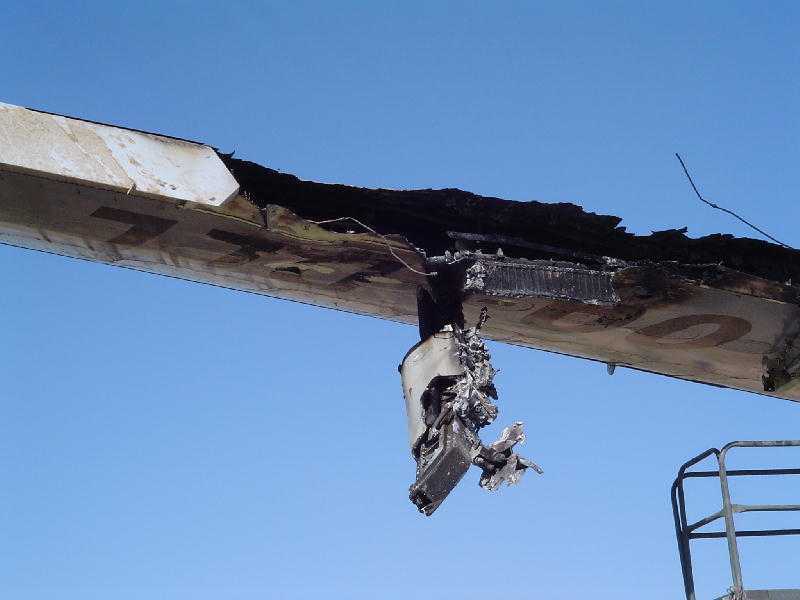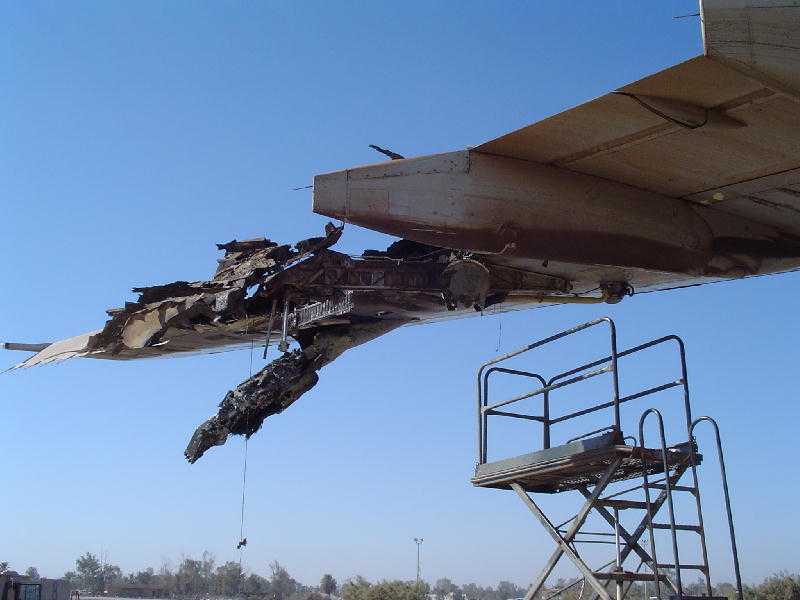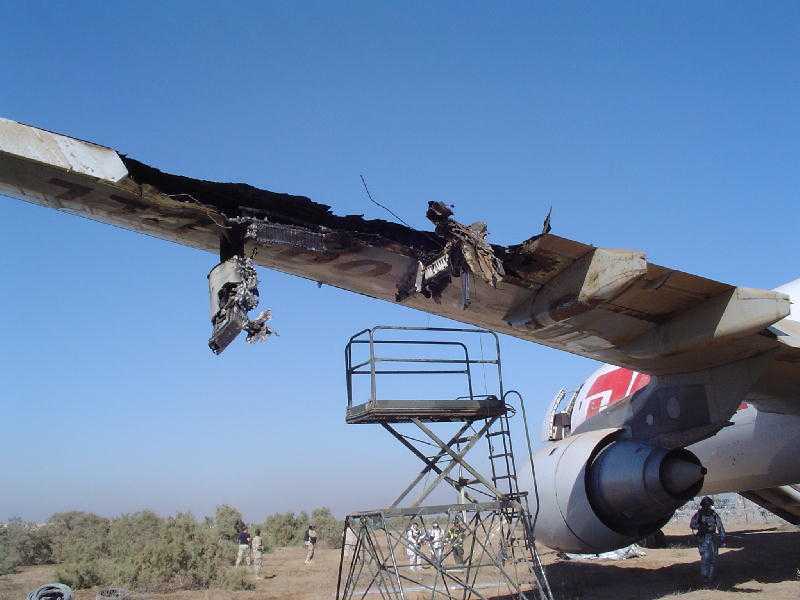On 23 February 2008, a B-2 bomber from the 509th Bomb wing of Whiteman AFB, MO, crashed while taking off from Andersen AFB in Guam. Both pilots successfully ejected, sustained only minor injuries. injuries to his left arm and shoulder.
The investigation concluded that water distorted preflight readings in three of the plane's 24 sensors, making the aircraft's control computer force the B-2 to pitch up on takeoff, resulting in a stall and subsequent crash. The sensors measure air pressure to help calculate everything from airspeed to altitude. Because of the bad data, flight computers had inaccurate airspeed and wrongly indicated a downward angle, which contributed to an early rotation and uncontrolled 30-degree pitch up.
The executive summary of the accident report stated that a technique developed two years prior to the crash, but at the time of the accident not widely known in the B-2 community, probably would have prevented the crash. The technique essentially heats the sensors and evaporates any moisture before data calibrations. The technique was never formalized in a technical order change or captured in 'lessons learned' reports, so only some pilots and some maintenance technicians knew of the suggestion.
Maj. Gen. Floyd L. Carpenter, who headed an accident investigation board, stated that the crash probably could have been avoided if knowledge of a technique to evaporate the moisture had been disseminated throughout the B-2 program. General Carpenter said procedures and policies are now in place to guard against similar crashes.
The accident aircraft had been in service since 1995, and was expected to remain in service for another 50 years. This was the first crash of a B-2, and there are now 20 aircraft left in the fleet.
The video that was produced by Glenn Pew includes the takeoff and crash sequence, and also shows a reconstruction of the event, using computer animation based on data from the flight.
Crash Video and Computer Reconstruction
28 April 2008
Review of 2003 Missile Strike on a DHL A300 over Baghdad
On 22 November 2003, a DHL A300, which had just departed from Baghdad on a cargo flight to Bahrain, was hit by a SAM-7 surface to air missile. The left wing caught fire following the hit, forcing the crew to return to the airport for a successful emergency landing.
A video about the event that was produced by Glenn Pew shows a reconstruction of the event, as well as several still photos of the missile damage.
Additional Damage Photos



AirSafe.com Review of the A300 Event
http://www.airsafe.com/journal/v1num18.htm
AirSafe.com Review of a 2002 Missile Attack in Kenya
http://www.airsafe.com/journal/v1num17.htm
A video about the event that was produced by Glenn Pew shows a reconstruction of the event, as well as several still photos of the missile damage.
Additional Damage Photos



AirSafe.com Review of the A300 Event
http://www.airsafe.com/journal/v1num18.htm
AirSafe.com Review of a 2002 Missile Attack in Kenya
http://www.airsafe.com/journal/v1num17.htm
Analysis of an In-flight Breakup of an F-15C over Missouri
On 2 November 2007, an F-15C aircraft from the Missouri Air National Guard experienced an in-flight breakup during an training mission. The pilot, Major Steven Stillwell, successfully ejected, but sustained injuries to his left arm and shoulder.
The investigation revealed that the accident aircraft had a structural failure in its upper right longeron, one of four critical support structures for the aircraft. Fatigue cracks in the longeron led to a structural failure of the longeron and the subsequent catastrophic breakup.
After the accident, more than 600 USAF F-15s were grounded and inspected. At least nine other F-15 aircraft were found to have similar fatigue cracks. some F-15s were also removed from service because of the costs of repairing these structural problems.
The video that was produced by Glenn Pew shows a reconstruction of the event, using computer animation based on data from the flight.
Reconstruction of the In-flight Breakup
Executive Summary of the USAF Accident Report
http://usaf.aib.law.af.mil/F-15C_LambertField_02Nov07.pdf
The investigation revealed that the accident aircraft had a structural failure in its upper right longeron, one of four critical support structures for the aircraft. Fatigue cracks in the longeron led to a structural failure of the longeron and the subsequent catastrophic breakup.
After the accident, more than 600 USAF F-15s were grounded and inspected. At least nine other F-15 aircraft were found to have similar fatigue cracks. some F-15s were also removed from service because of the costs of repairing these structural problems.
The video that was produced by Glenn Pew shows a reconstruction of the event, using computer animation based on data from the flight.
Reconstruction of the In-flight Breakup
Executive Summary of the USAF Accident Report
http://usaf.aib.law.af.mil/F-15C_LambertField_02Nov07.pdf
24 April 2008
Air-to-air Shootdown from the Target Perspective
In the history of aviation, there have been many videos of missile attacks from the attacker's perspective, it is rare to have one from the other side. Below is a video shot from a Georgian Hermes 450 unmanned aerial vehicle (UAV) patrolling over the Abkhazia region of Georgia when it was apparently shot down by a missile from a Russian MIG-29. The Israeli-designed unarmed UAV never had a chance.
Georgian Military Official Describes the Attack
Related Resources
Attack on an A300 by a Portable Missile: http://www.airsafe.com/journal/v1num18.htm
Threats from Portable Surface to Air Missiles: http://www.airsafe.com/journal/v1num17.htm
Hermes 450

Georgian Military Official Describes the Attack
Related Resources
Attack on an A300 by a Portable Missile: http://www.airsafe.com/journal/v1num18.htm
Threats from Portable Surface to Air Missiles: http://www.airsafe.com/journal/v1num17.htm
Hermes 450

03 March 2008
Lufthansa A320 Has Close Call in Hamburg
On 1 March 2008, a Lufthansa Airbus A320 arriving from Munich was attempting a landing at Hamburg, Germany under high crosswind conditions. The left wingtip struck the ground during the attempt, and the crew successfully executed a go-around. The aircraft landed without further incident. At the time, winds at the airport were gusting up to 49 knots. The left wingtip and winglet were damaged, and there were no injuries to any occupants..
Video of the Event
Photos of Event and the Aircraft Damage



Video of the Event
Photos of Event and the Aircraft Damage



21 February 2008
Investigation Update #3 for the British Airways 777 Crash of 17 January 2008
This is the third update from AirSafe.com on the ongoing investigation into the accident at London's Heathrow Airport involving a British Airways 777. This update is based on information released by the AAIB on 18 February 2008, and focuses on analyses of the fuel system, the engines, and their associated control systems. You can listen to or watch the podcast at the following links:
Audio: MP3 | Video: iPod/MP4 | WMV | Google Video | YouTube
The links below will take you to additional related resources.
Additional Details About this Accident: http://777.airsafe.org
Transcript and Timeline for this Podcast
Other Podcasts
Video of the Podcast
Audio: MP3 | Video: iPod/MP4 | WMV | Google Video | YouTube
The links below will take you to additional related resources.
Additional Details About this Accident: http://777.airsafe.org
Transcript and Timeline for this Podcast
Other Podcasts
Video of the Podcast
14 February 2008
Crash of British Airways 777 at Heathrow on 17 January 2008 - Update 2
The Air Accidents Investigations Branch (AAIB), the UK organization responsible for investigating the 17 January 2008 crash of a British Airways 777 jet at London's Heathrow Airport, released a second statement about the progress of the investigation on 23 January 2008. The video below summarizes the information in that second AAIB statement.
Labels:
777,
aaib,
airwasy,
british,
crash,
evacuation,
heathrow,
investigation,
london,
passenger
Subscribe to:
Posts (Atom)









